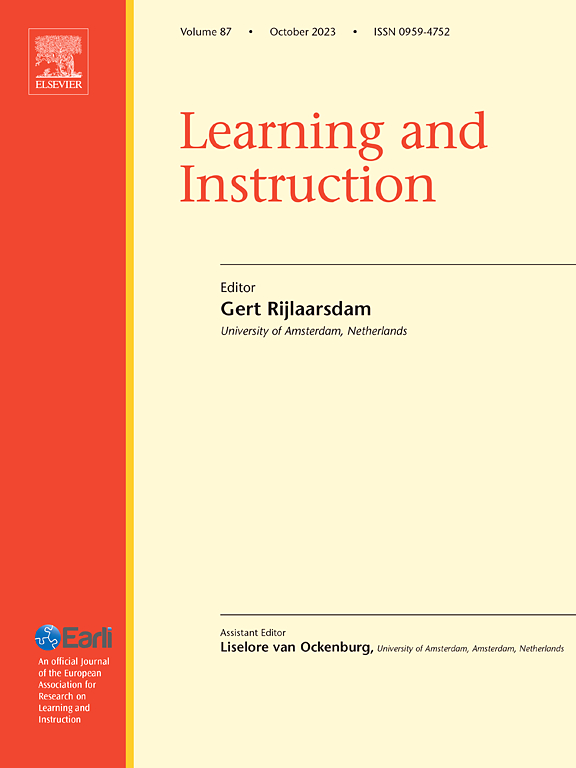学生参与的复杂动态系统方法
IF 4.9
1区 教育学
Q1 EDUCATION & EDUCATIONAL RESEARCH
引用次数: 0
摘要
多模态数据分析主要通过三种途径进行:(1)联合效应法,(2)三角化法,(3)独立潜在构念法。虽然这些方法提高了我们对学习过程的理解,但它们未能捕捉到学习过程的动态性和突发性。目的通过复杂动力系统(CDS)的视角研究多模态数据。我们调查了CDS方法是否可以为预测和理解学习过程中的认知参与提供独特的见解。参与者包括61名三年级医学生(47.5%为女性)。方法从CDS角度分析了参与互动学习环境的参与者的眼睛注视、头部姿势和面部动作单元。结果我们发现,眼睛注视、头部姿势和面部表情等特定参数显著预测认知参与水平。网络密度也被认为是认知投入的重要预测指标。值得注意的是,与考虑的任何其他个体变量相比,网络密度解释了认知投入变化的更大比例。此外,我们发现低参与度组的学生在行为指标之间表现出一贯的弱但稳定的相互联系,而高参与度组的学生在变量之间表现出紧密的集群互动模式。这些发现突出了CDS方法对认知参与动态复杂性建模的附加价值。本研究是重新思考多模态学习分析研究议程的重要一步。在方法上,本研究证明了基于cd的分析技术在了解参与和学习背后的生理和心理过程方面的潜力。本文章由计算机程序翻译,如有差异,请以英文原文为准。
A complex dynamical system approach to student engagement
Background
Multimodal data analysis has been approached through three main avenues: (1) joint effect approach, (2) triangulation approach, and (3) separate latent construct approach. While these approaches have advanced our understanding of the learning process, they fail to capture its dynamic and emergent nature.
Aim
This study examines multimodal data through the lens of complex dynamical system (CDS) approach. We investigated whether a CDS approach could provide unique insights into predicting and understanding cognitive engagement during learning.
Sample
The participants comprised 61 third-year medical students (47.5 % females).
Methods
From a CDS perspective, we analyzed eye gaze, head pose, and facial action units of participants engaged in an interactive learning environment.
Results
We found that specific parameters of eye gaze, head pose, and facial expressions significantly predicted cognitive engagement levels. Network density was also identified as a significant predictor of cognitive engagement. Notably, network density explained a greater proportion of the variation in cognitive engagement compared to any other individual variable considered. Additionally, we found that students in the low engagement group demonstrated consistently weak but stable interconnections among behavioral indicators, while the high engagement group displayed tightly clustered interaction patterns among variables.
Conclusions
These findings highlight the added value of a CDS approach for modeling the dynamic complexity of cognitive engagement. This study represents a significant step in rethinking the research agenda in multimodal learning analytics. Methodologically, this study demonstrates the potential of CDS-based analytical techniques for gaining insights into physiological and psychological processes underlying engagement and learning.
求助全文
通过发布文献求助,成功后即可免费获取论文全文。
去求助
来源期刊

Learning and Instruction
Multiple-
CiteScore
11.30
自引率
4.80%
发文量
109
期刊介绍:
As an international, multi-disciplinary, peer-refereed journal, Learning and Instruction provides a platform for the publication of the most advanced scientific research in the areas of learning, development, instruction and teaching. The journal welcomes original empirical investigations. The papers may represent a variety of theoretical perspectives and different methodological approaches. They may refer to any age level, from infants to adults and to a diversity of learning and instructional settings, from laboratory experiments to field studies. The major criteria in the review and the selection process concern the significance of the contribution to the area of learning and instruction, and the rigor of the study.
 求助内容:
求助内容: 应助结果提醒方式:
应助结果提醒方式:


